Thomas Zemen
Site-Specific Radio Channel Representation -- Current State and Future Applications
Jun 18, 2024Abstract:A site-specific radio channel representation considers the surroundings of the communication system through the environment geometry, such as buildings, vegetation, and mobile objects including their material and surface properties. In this article, we focus on communication technologies for 5G and beyond that are increasingly able to exploit the specific environment geometry for both communication and sensing. We present methods for a site-specific radio channel representation that is spatially consistent, such that mobile transmitter and receveiver cause a correlated time-varying channel impulse response. When modelled as random, this channel impulse response has non-stationary statistical properties, i.e., a time-variant Doppler spectrum, power delay profile, K-factor and spatial correlation. A site-specific radio channel representation will enable research into emerging 5G and beyond technologies such as distributed multiple-input multiple-output systems, reconfigurable intelligent surfaces, multi-band communication, and joint communication and sensing. These 5G and beyond technologies will be deployed for a wide range of environments, from dense urban areas to railways, road transportation, industrial automation, and unmanned aerial vehicles.
Ray Tracing Algorithm for Reconfigurable Intelligent Surfaces
Feb 20, 2024Abstract:Ray tracing accelerated with graphics processing units (GPUs) is an accurate and efficient simulation technique of wireless communication channels. In this paper, we extend a GPU-accelerated ray tracer (RT) to support the effects of reconfigurable intelligent surfaces (RISs). To evaluate the electric field, we derived a RIS path loss model that can be integrated into a RT and enables further extensions for the implementation of additional features and incorporation into complex reflective scenarios. We verify the derivation and implementation of our model by comparison with empirical measurements in a lab environment. We demonstrate the capabilities of our model to support higher-order reflections from the RIS to the receiver. We find that such components have a significant effect on the received signal strength, concluding that the extensions of advanced functionality enabled by our model play an important role in the accurate modeling of radio wave propagation in an environment including RISs.
Methodologies for Future Vehicular Digital Twins
Dec 15, 2023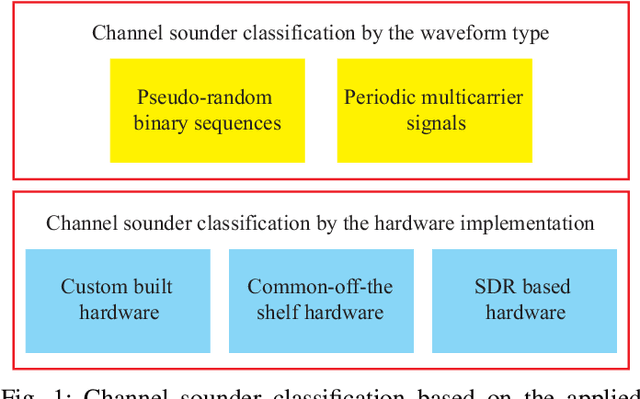
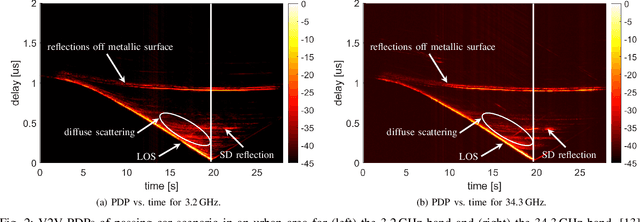
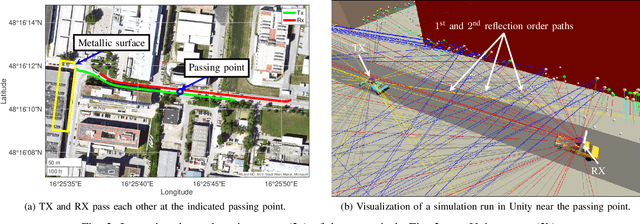
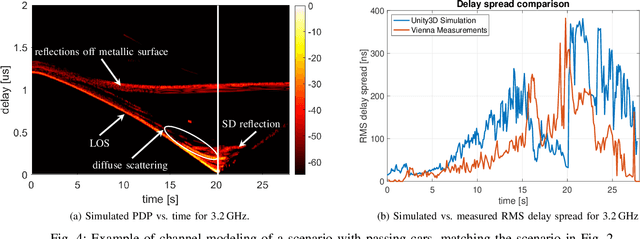
Abstract:The role of wireless communications in various domains of intelligent transportation systems is significant; it is evident that dependable message exchange between nodes (cars, bikes, pedestrians, infrastructure, etc.) has to be guaranteed to fulfill the stringent requirements for future transportation systems. A precise site-specific digital twin is seen as a key enabler for the cost-effective development and validation of future vehicular communication systems. Furthermore, achieving a realistic digital twin for dependable wireless communications requires accurate measurement, modeling, and emulation of wireless communication channels. However, contemporary approaches in these domains are not efficient enough to satisfy the foreseen needs. In this position paper, we overview the current solutions, indicate their limitations, and discuss the most prospective paths for future investigation.
Channel Estimation for mmWave MIMO using sub-6 GHz Out-of-Band Information
Nov 16, 2023Abstract:Future wireless multiple-input multiple-output (MIMO) communication systems will employ sub-6 GHz and millimeter wave (mmWave) frequency bands working cooperatively. Establishing a MIMO communication link usually relies on estimating channel state information (CSI) which is difficult to acquire at mmWave frequencies due to a low signal-to-noise ratio (SNR). In this paper, we propose three novel methods to estimate mmWave MIMO channels using out-of-band information obtained from the sub-6GHz band. We compare the proposed channel estimation methods with a conventional one utilizing only in-band information. Simulation results show that the proposed methods outperform the conventional mmWave channel estimation method in terms of achievable spectral efficiency, especially at low SNR and high K-factor.
Active Reconfigurable Intelligent Surfaces for the Millimeter-Wave Frequency Band: System Design and Measurement
Jun 07, 2023



Abstract:Reconfigurable intelligent surfaces (RISs) will play a key role to establish millimeter wave (mmWave) ultra-reliable low-latency communication systems for sixth-generation (6G) applications. Currently, there are a few working prototypes of RISs operating in the mmWave frequency band and all of them are based on passive reflective elements. However, to fabricate an efficiently working RIS at mmWave frequencies, it is crucial to take care of the strong signal attenuation, reflective element losses and undesired radio frequency (RF) circuit effects. In this paper, we provide measurement campaign results for an active RIS in the mmWave frequency band as well as its analysis and system design. The obtained results demonstrate that an active RIS outperforms a RIS working in passive mode and provides a higher signal-to-noise-ratio (SNR). The active RIS consists of active reflective elements that amplify the impinging signal and reflect the signal to the desired beam direction. To obtain an efficient RIS in terms of power consumption and RIS state switch time, we design a hexagonal RIS with 37 elements working at 26 GHz. These elements are designed to work whether in passive state (binary phase shifting) or in active state (switch OFF or amplifying). We provide a comparison between the performance of a RIS working in passive and active mode using numerical simulations and empirical measurements. This comparison reveals that the active reflective intelligent surface (RIS) provides a received power that is at least 4 dB higher than that of the equivalent passive RIS. These results demonstrate the strong advantage of using active RISs for future ultra-reliable low-latency wireless communications.
Frame Error Rate Prediction for Non-Stationary Wireless Vehicular Communication Links
Apr 12, 2023Abstract:Wireless vehicular communication will increase the safety of road users. The reliability of vehicular communication links is of high importance as links with low reliability may diminish the advantage of having situational traffic information. The goal of our investigation is to obtain a reliable coverage area for non-stationary vehicular scenarios. Therefore we propose a deep neural network (DNN) for predicting the expected frame error rate (FER). The DNN is trained in a supervised fashion, where a time-limited sequence of channel frequency responses has been labeled with its corresponding FER values assuming an underlying wireless communication system, i.e. IEEE 802.11p. For generating the training dataset we use a geometry-based stochastic channel model (GSCM). We obtain the ground truth FER by emulating the time-varying frequency responses using a hardware-in-the-loop setup. Our GSCM provides the propagation path parameters which we use to fix the statistics of the fading process at one point in space for an arbitrary amount of time, enabling accurate FER estimation. Using this dataset we achieve an accuracy of 85% of the DNN. We use the trained model to predict the FER for measured time-varying channel transfer functions obtained during a measurement campaign. We compare the predicted output of the DNN to the measured FER on the road and obtain a prediction accuracy of 78%.
Stationarity Evaluation of High-mobility sub-6 GHz and mmWave non-WSSUS Channels
Apr 03, 2023Abstract:Analysis and modeling of wireless communication systems are dependent on the validity of the wide-sense stationarity uncorrelated scattering (WSSUS) assumption. However, in high-mobility scenarios, the WSSUS assumption is approximately fulfilled just over a short time period. This paper focuses on the stationarity evaluation of high-mobility multi-band channels. We evaluate the stationarity time, the time over which WSSUS is fulfilled approximately. The investigation is performed over real, measured high-mobility channels for two frequency bands, 2.55 and 25.5 GHz. Furthermore, we demonstrate the influence of the user velocity on the stationarity time. We show that the stationarity time decreases with increased relative velocity between the transmitter and the receiver. Furthermore, we show the similarity of the stationarity regions between sub-6 GHz and mmWave channels. Finally, we demonstrate that the sub-6 GHz channels are characterized by longer stationarity time.
Towards Cell-Free Massive MIMO: A Measurement-Based Analysis
Jul 04, 2022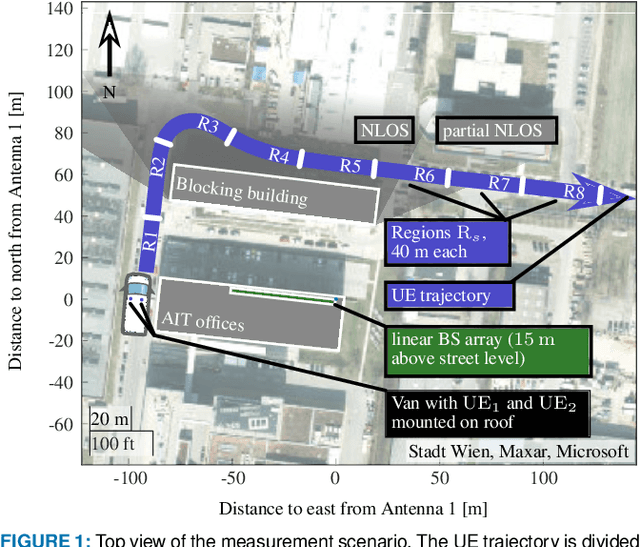
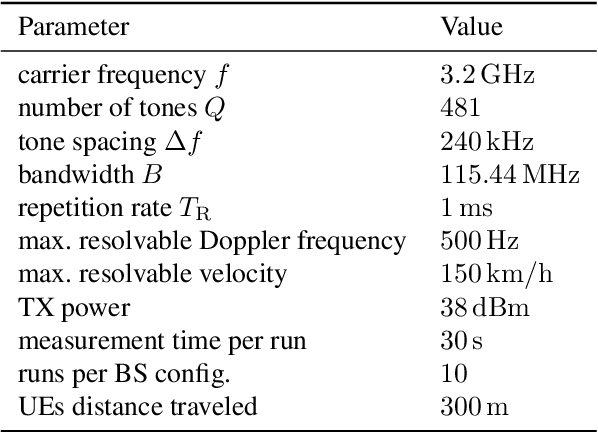
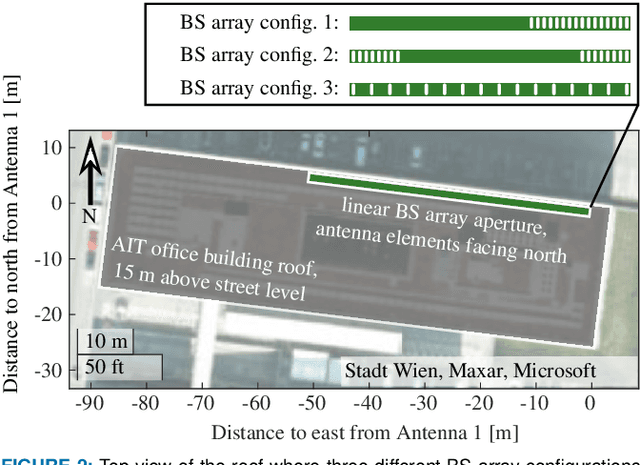
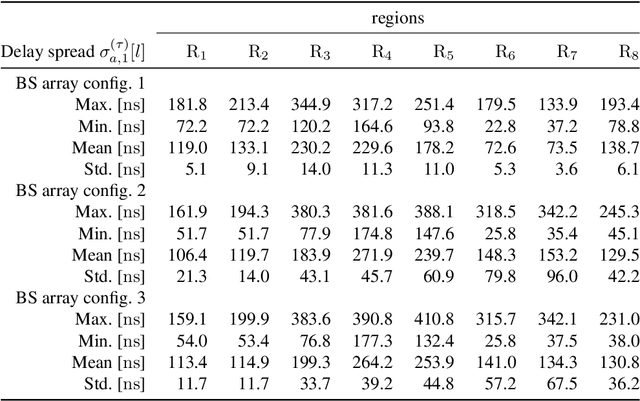
Abstract:Cell-free widely distributed massive multiple-input multiple-output (MIMO) systems utilize radio units spread out over a large geographical area. The radio signal of a user equipment (UE) is coherently detected by a subset of radio units (RUs) in the vicinity of the UE and processed jointly at the nearest baseband processing unit (BPU). This architecture promises two orders of magnitude less transmit power, spatial focusing at the UE position for high reliability, and consistent throughput over the coverage area. All these properties have been investigated so far from a theoretical point of view. To the best of our knowledge, this work presents the first empirical radio wave propagation measurements in the form of time-variant channel transfer functions for a linear, widely distributed antenna array with 32 single antenna RUs spread out over a range of 46.5 m. The large aperture allows for valuable insights into the propagation characteristics of cell-free systems. Three different co-located and widely distributed RU configurations and their properties in an urban environment are analyzed in terms of time-variant delay-spread, Doppler spread, path loss and the correlation of the local scattering function over space. For the development of 6G cell-free massive MIMO transceiver algorithms, we analyze properties such as channel hardening, channel aging as well as the signal to interference and noise ratio (SINR). Our empirical evidence supports the promising claims for widely distributed cell-free systems.
Multi-Link Vehicular Wireless Channel Modelling: Impact of Large Obstructing Vehicles
Mar 11, 2021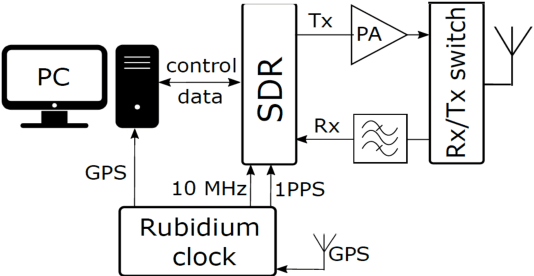

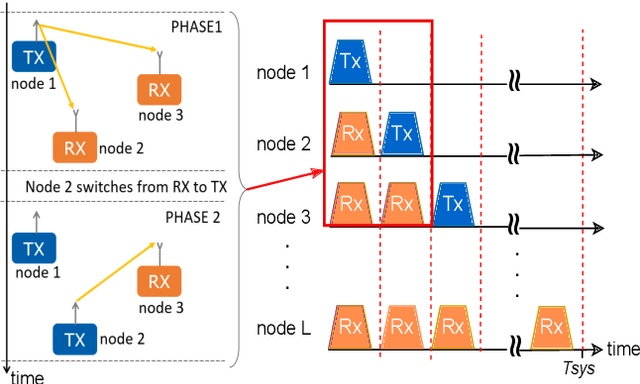

Abstract:Multi-node channel sounding simultaneously captures multiple channel transfer functions in complex scenarios. It ensures that measurement conditions are identical for all observed links. This is particularly beneficial in analyzing highly-dynamic vehicular communication scenarios, where the measurement conditions and wireless channel statistics change rapidly. We present the first fully mobile multi-node vehicular wireless channel sounding results. We analyze the impact of a double-decker bus on the channel statistics in two measurement scenarios. The measurement data is used to calibrate an OpenStreetMap geometry-based stochastic channel model and include a more accurate modeling for large vehicles, absent from previous models. We validate our model using a link-level emulation, demonstrating a good match with measurement data. Finally, we propose a relaying scenario and test it on link-level by comparing the time-variant error rates of measured links.
Real-Time Vehicular Wireless System-Level Simulation
Dec 22, 2020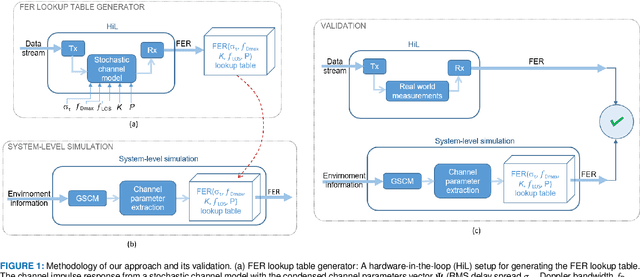
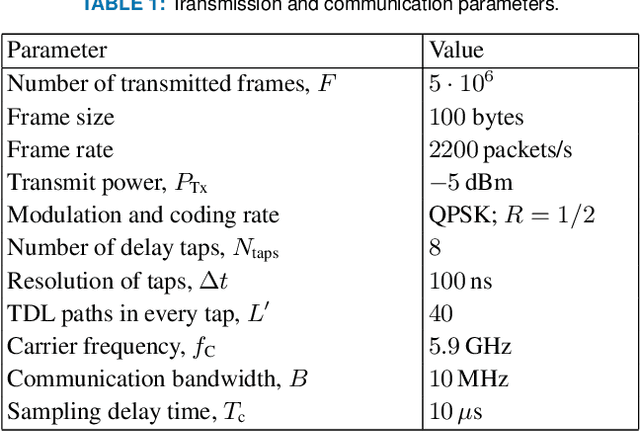


Abstract:Future automation and control units for advanced driver assistance systems (ADAS) will exchange sensor and kinematic data with nearby vehicles using wireless communication links to improve traffic safety. In this paper we present an accurate real-time system-level simulation for multi-vehicle communication scenarios to support the development and test of connected ADAS systems. The physical and data-link layer are abstracted and provide the frame error rate (FER) to a network simulator. The FER is strongly affected by the non-stationary doubly dispersive fading process of the vehicular radio communication channel. We use a geometry-based stochastic channel model (GSCM) to enable a simplified but still accurate representation of the non-stationary vehicular fading process. The propagation path parameters of the GSCM are used to efficiently compute the time-variant condensed radio channel parameters per stationarity region of each communication link during run-time. Five condensed radio channel parameters mainly determine the FER forming a parameter vector: path loss, root mean square delay spread, Doppler bandwidth, $K$-factor, and line-of-sight Doppler shift. We measure the FER for a pre-defined set of discrete grid points of the parameter vector using a channel emulator and a given transmitter-receiver modem pair. The FER data is stored in a table and looked up during run-time of the real-time system-level simulation. We validate our methodology using empirical measurement data from a street crossing scenarios demonstrating a close match in terms of FER between simulation and measurement.
 Add to Chrome
Add to Chrome Add to Firefox
Add to Firefox Add to Edge
Add to Edge